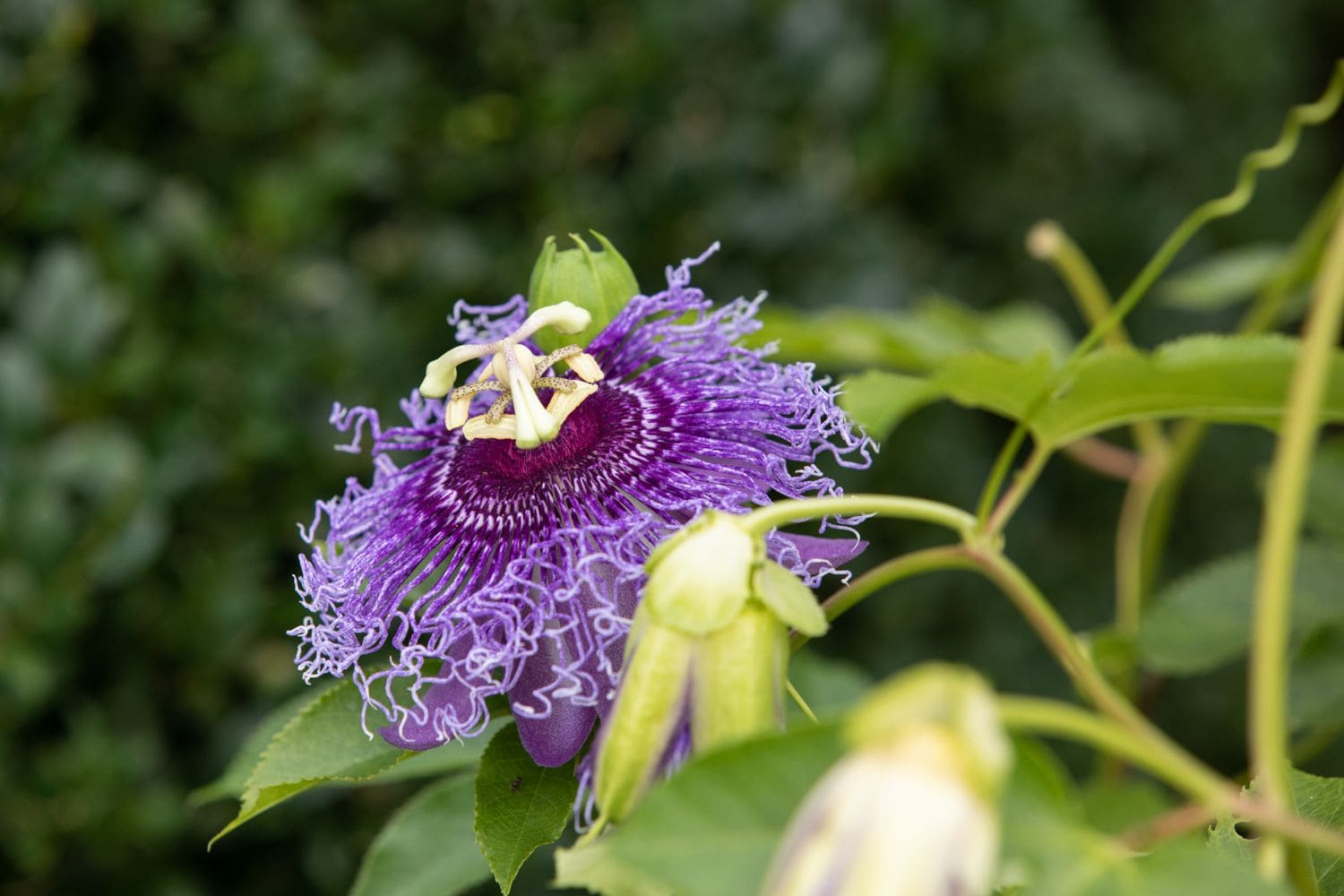I’ll never forget the first time I spotted a purple passion flower blooming on a roadside fence during a summer drive through Tennessee. The intricate, almost alien-looking bloom stopped me in my tracks—literally.
I pulled over, mesmerized by the purple and white fringed corona that looked like something from another planet. That moment sparked a decade-long love affair with this remarkable native vine that has taught me both the joys and challenges of growing one of North America’s most spectacular flowering plants.
If you’ve ever been captivated by the exotic beauty of Passiflora incarnata, commonly known as purple passion flower or maypop, you’re in for a treat. This comprehensive guide will walk you through everything you need to know about successfully growing, managing, and enjoying this fascinating native vine.
What Makes Purple Passion Flower Special?
Purple passion flower stands out as one of the hardiest members of the passionflower family, naturally occurring from Pennsylvania down to Florida and west to Texas. Unlike its tropical cousins, this North American native can withstand temperatures as low as -5°F when properly mulched, making it accessible to gardeners in USDA zones 5-9.
The plant’s most striking feature is undoubtedly its flowers. Each bloom appears to be crafted by a master jeweler—five pale purple petals surround an intricate crown of wavy filaments striped in purple and white, with prominent stamens and pistils rising from the center like tiny sculptures.
These 2-3 inch wide flowers bloom continuously from June through September, with each individual flower lasting just one day before making way for the next spectacular display.
What makes these flowers truly remarkable is their sophisticated pollination mechanism. When carpenter bees and bumblebees visit for nectar, they must push past the ring of filaments and climb over the reproductive parts, ensuring their bodies become thoroughly dusted with pollen.
The flower’s design is so effective that these bees often become visibly intoxicated from the nectar—a phenomenon observers have noted since the 1800s, watching “drunk” bees stumbling around the blooms.
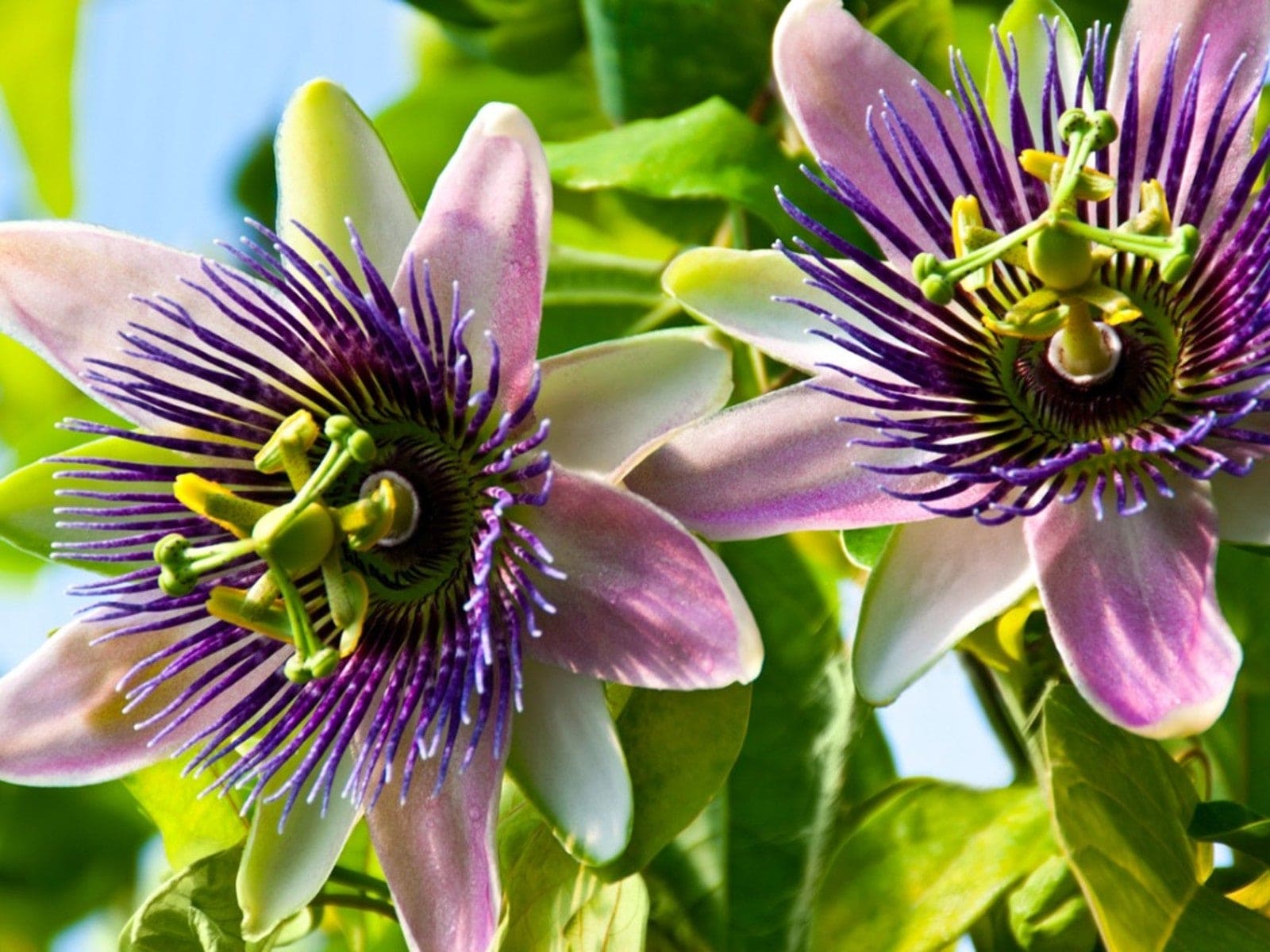
But the show doesn’t end with the flowers. By late summer, the vine produces egg-shaped fruits called maypops—so named because they make a distinctive popping sound when stepped on. These yellowish-green fruits are not only edible but deliciously sweet-tart, tasting remarkably similar to their tropical passion fruit cousins.
Understanding Your Growing Environment
Sunlight and Location Requirements
Purple passion flower is a sun-worshipper at heart. While it can tolerate partial shade, you’ll get the most abundant flowering and fruiting in locations that receive 6-8 hours of direct sunlight daily. In my experience, vines grown in full sun produce twice as many flowers as those in shadier spots.

Choose a location protected from harsh winter winds but with good air circulation during the growing season. A south or west-facing fence or wall provides ideal conditions, offering both sun exposure and wind protection.
Soil Preparation and Amendments
One of the things I love most about this plant is its adaptability to different soil types. Whether you have clay, sandy loam, or anything in between, purple passion flower will likely thrive as long as drainage is adequate. The plant actually prefers slightly poor to average soil—overly rich soil can lead to excessive leafy growth at the expense of flowers.
For optimal results, prepare your planting area by working compost into the existing soil at a ratio of one part compost to two parts native soil. This improves drainage in clay soils while adding organic matter to sandy soils.
The ideal soil pH ranges from 6.1 to 7.8, but I’ve seen healthy vines growing in everything from slightly acidic to mildly alkaline conditions.
If your soil tends to stay wet, consider creating a raised planting area or adding coarse sand and perlite to improve drainage. Poor drainage is one of the few conditions that can seriously harm this otherwise resilient plant.
👉 Here’s How to Prepare Land for Planting: A Comprehensive Guide for Gardeners and Farmers
Climate Adaptability by Zone
Understanding how purple passion flower behaves in your specific hardiness zone helps set realistic expectations.
- In zones 8-9, the vine often maintains woody stems through winter, requiring only light pruning.
- Zone 7 gardeners typically see the vine die back partially, with some stem survival in protected locations.
- In zones 5-6, expect complete winter die-back to the ground, with vigorous spring emergence from the root system.
This natural dormancy cycle actually benefits the plant, as it prevents the accumulation of pest and disease issues that might plague evergreen vines in similar climates.
Planting Your Purple Passion Flower
Site Selection Strategy
Choosing the right location is crucial for long-term success. I learned this lesson the hard way when I planted my first vine too close to a vegetable garden—within two years, passion flower runners were popping up between my tomato plants!
Look for a spot that offers full sun to partial shade, well-draining soil, adequate space for spreading (this vine can easily cover 200 square feet), a strong support structure for climbing, and protection from harsh winter winds.
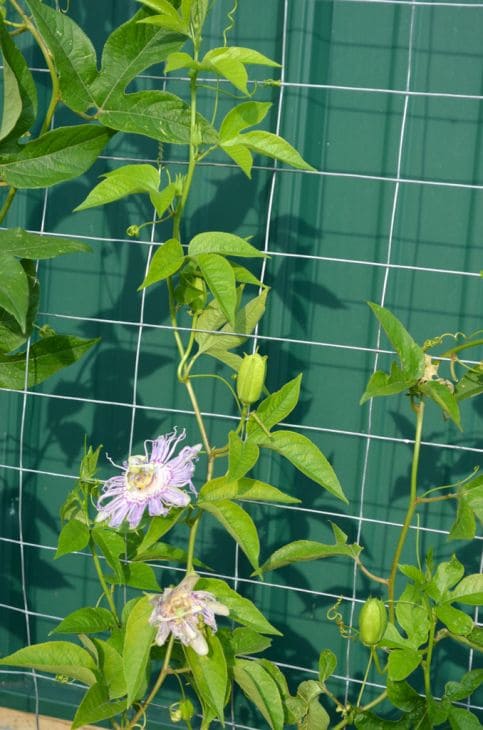
Remember that this plant will be with you for many years and will expand significantly, so err on the side of giving it more space rather than less.
Support Structure Installation
Purple passion flower climbs using tendrils, so it needs something to grab onto. Install your support system before planting to avoid disturbing the roots later.
My favorite setups include chain-link fencing, which provides countless attachment points, wooden trellises at least 6-8 feet tall with horizontal slats every 12 inches, wire mesh panels that are both sturdy and relatively inexpensive, and existing structures like fences, pergolas, or arbors.
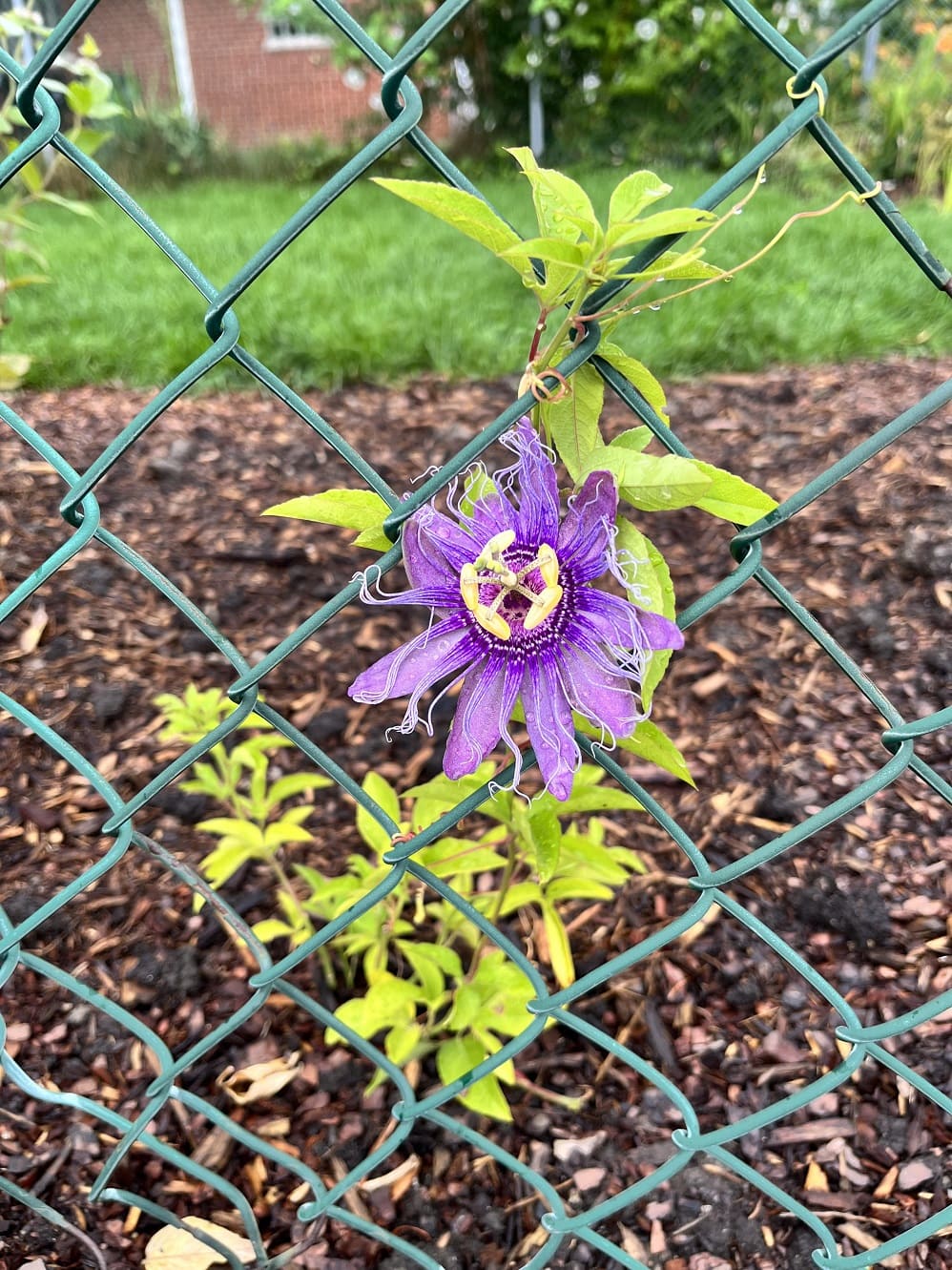
The support needs to be robust—a mature vine can become quite heavy, especially when loaded with fruit or after rain.
👉 Explore 25+ Creative Pole Bean Support Ideas That Actually Work for Your Garden
Planting Process
Plant after the last frost date in your area, typically late April to early June depending on your zone. Clear a 3-foot diameter area of weeds and grass, then dig a hole twice as wide as the root ball and just as deep. This wide planting hole encourages roots to spread laterally rather than circling.
Remove the plant from its container and gently tease apart any circling roots. Place the plant at the same depth it was growing in the pot—planting too deep can lead to stem rot. Backfill with your prepared soil mixture, watering thoroughly as you go to eliminate air pockets.
Apply 2-3 inches of organic mulch around the base, keeping it 6 inches away from the stem to prevent moisture-related problems. Water deeply and install temporary stakes if the young plant seems unstable.
👉 Here’s How to Turn Fall Leaves into Soil Enriching Mulch For a Nutrient-Rich Garden
Mastering Watering and Fertilization
Watering Techniques That Work
Proper watering makes the difference between a struggling vine and a thriving one. Purple passion flower prefers consistent moisture during the growing season but abhors soggy conditions. Water deeply once or twice weekly rather than frequent shallow watering, which encourages surface roots and reduces drought tolerance.
I’ve found that morning watering works best, giving the plant time to absorb moisture before the day’s heat while allowing excess water to evaporate before evening.
During the first growing season, maintain consistent soil moisture as the root system establishes. Once established, the vine becomes surprisingly drought tolerant, though flowering and fruiting improve with regular water.
In container situations, check soil moisture every few days during summer, as pots dry out more quickly than ground plantings. Water when the top inch of soil feels dry but before the plant shows stress signs.
Fertilization for Maximum Performance
Purple passion flower benefits from regular feeding during the growing season, but the approach matters. Too much nitrogen creates lush foliage at the expense of flowers, while balanced nutrition supports both growth and blooming.
Apply a balanced fertilizer like 10-10-10 in early spring as new growth emerges, working it gently into the soil around the base. During the active growing season, side-dress with compost or apply a diluted liquid fertilizer every 4-6 weeks. I prefer organic options like fish emulsion or compost tea, which provide gentle, sustained nutrition.
Container plants need more frequent feeding since nutrients wash out with regular watering. Use a balanced liquid fertilizer every 2-3 weeks during the growing season, but reduce feeding in late summer to help the plant prepare for dormancy.
Stop all fertilization by late August to allow the plant to naturally harden off for winter.
Container Growing Success
Choosing the Right Container Setup
Growing purple passion flower in containers offers excellent control over its spread while maintaining all the beauty and wildlife benefits. Success depends on choosing an appropriately sized container and providing proper growing conditions.
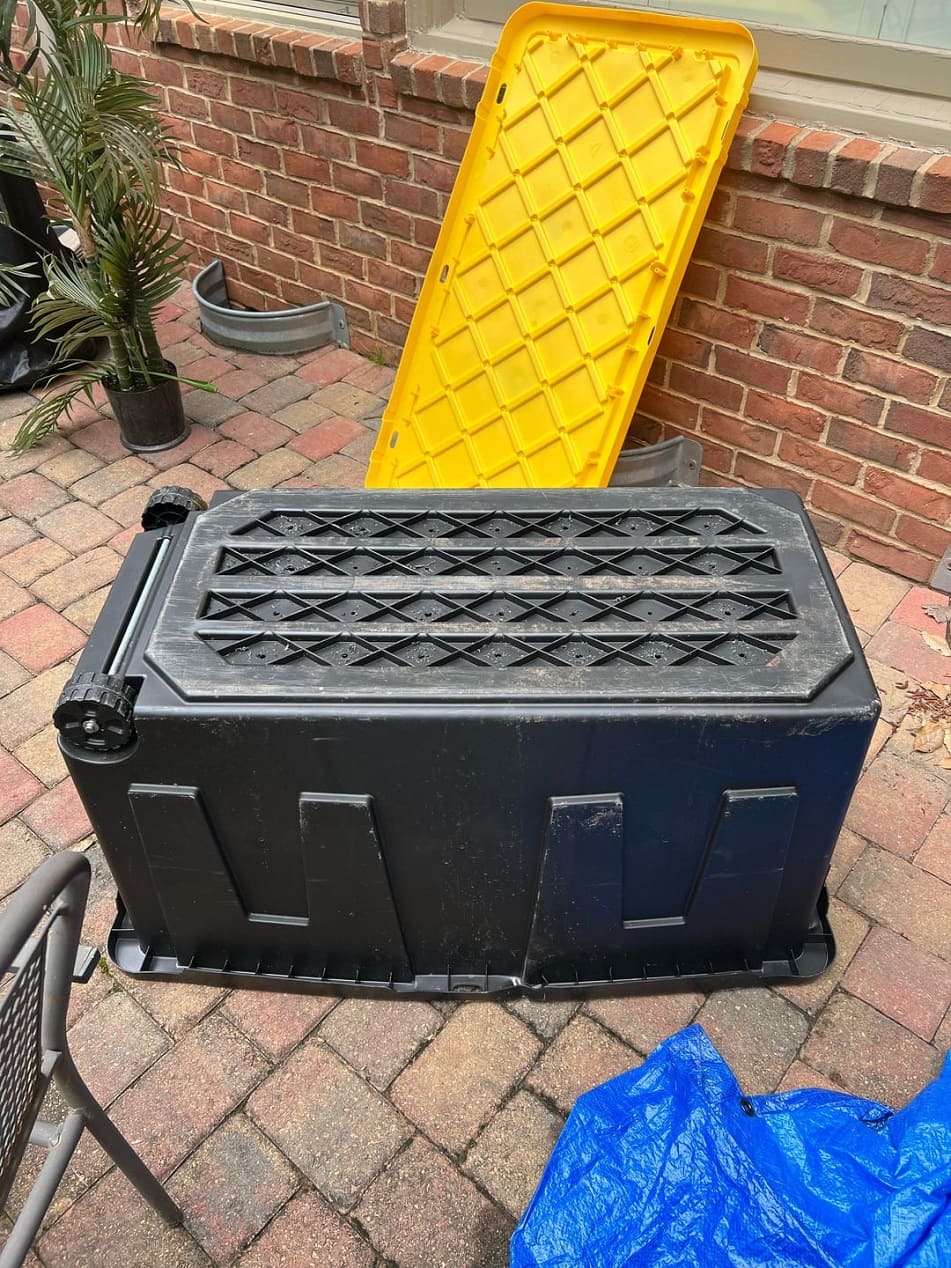
Start with a container at least 20 gallons in volume—smaller pots restrict root development and require constant watering. Half whiskey barrels, large ceramic pots, or purpose-built wooden planters work well. Ensure multiple drainage holes, as waterlogged roots quickly kill this otherwise resilient plant.

👉 Here’s How to Build a Wicking Bed: DIY Self‑Watering Raised Garden Guide
Container Soil and Management
Use a high-quality potting mix rather than garden soil, which becomes too dense in containers. I blend equal parts quality potting soil, compost, and coarse perlite or sand for optimal drainage and nutrition. This mixture provides good structure while retaining adequate moisture.
👉 Here’s How to Compost Sawdust: Pro Tips, Ratios & Risks Explained
Container vines need more attention than their ground-planted cousins. Check soil moisture regularly, provide weekly feeding during the growing season, and plan for annual root pruning or repotting every 2-3 years. The restricted root space actually helps control the vine’s aggressive tendencies while maintaining excellent flowering.
In cold climates, move containers to protected locations or wrap them for winter insulation. The roots are more vulnerable to freezing in containers than in the ground.
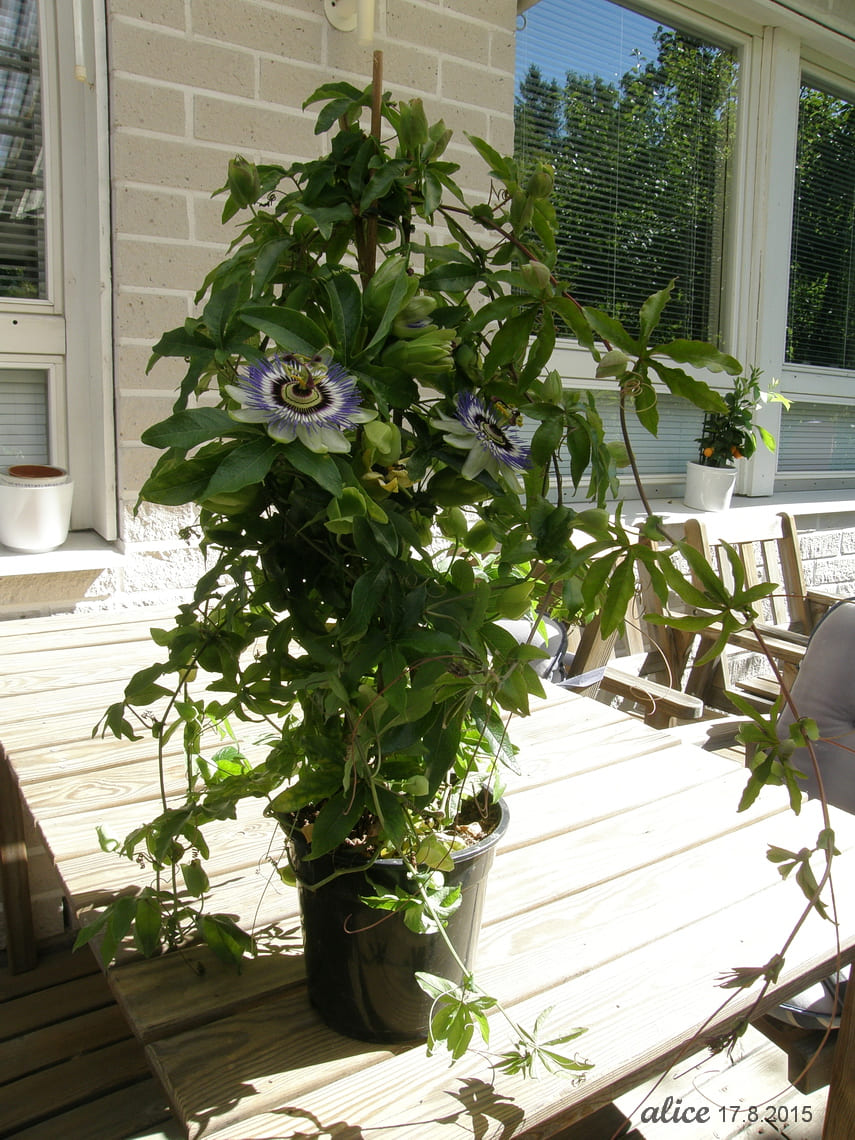
Seasonal Care and Maintenance
Spring Awakening (March-May)
Spring arrives with exciting signs of life from your passion flower. In early spring, cut back any dead growth from winter, leaving 6-12 inches of healthy stems. This pruning stimulates vigorous new growth and keeps the vine manageable.
👉 Here’s How to Prune Roses: A Simple Guide for Stunning Results
As soil temperatures warm, apply your balanced fertilizer around the root zone and refresh the mulch layer. Begin weekly watering as new growth emerges, and start training new shoots onto their support structure. This is also the ideal time for propagation activities and transplanting any unwanted runners.
Summer Glory (June-August)
Early summer brings the first flowers—a moment of pure gardening joy. Maintain consistent moisture during this peak growing period, but avoid overwatering. The vine grows rapidly now, requiring weekly training and tying to keep it organized on its support.
Mid-summer showcases peak blooming, when your patience pays off with daily floral displays. Watch for the first small fruits forming behind faded flowers. Late summer brings reduced watering as fruit development progresses and the plant’s growth naturally slows.
Autumn Transition (September-November)
Early fall marks harvest time for those precious maypops. The fruit ripens gradually, providing weeks of fresh treats. Continue harvesting until frost, and collect seeds if you want to try propagation.
As temperatures cool, allow the plant to begin its natural senescence. Reduce watering and avoid fertilizing, helping the vine prepare for dormancy. This is also when I do my major runner removal, pulling up unwanted shoots before they establish for next year.
Winter Rest (December-February)
Winter care varies dramatically by climate zone. In the coldest zones, cut stems to 12 inches and mulch heavily around the base for root protection. Warmer zones may see continued above-ground growth requiring only light pruning.
Use this quiet season to plan for spring expansion control and order any new plants or supplies you’ll need. It’s also the perfect time to research companion plants or plan garden modifications to better accommodate your vine’s growth.
Managing the Enthusiastic Spread
Let me be completely honest—purple passion flower can become enthusiastically invasive if left unchecked. The underground root system sends out runners that can surface 20 feet or more from the original plant. However, this vigor is manageable with the right strategies.
Containment Without Compromise
Root barriers installed 18-24 inches deep around the planting area using metal edging or landscape fabric provide excellent long-term control. For less permanent solutions, regular patrol walks during the growing season allow you to spot and remove new shoots while they’re small and easy to pull.
If runners appear in lawn areas, regular mowing gradually exhausts the root system. However, don’t rely on mowing alone in garden beds where the shoots can hide among other plants.
Strategic Pruning for Beauty and Control
I’ve discovered that strategic pruning actually improves flowering while controlling spread. Each late winter, cut all stems back to 2-3 feet from the base—this dramatic pruning stimulates vigorous new growth and abundant flowering.
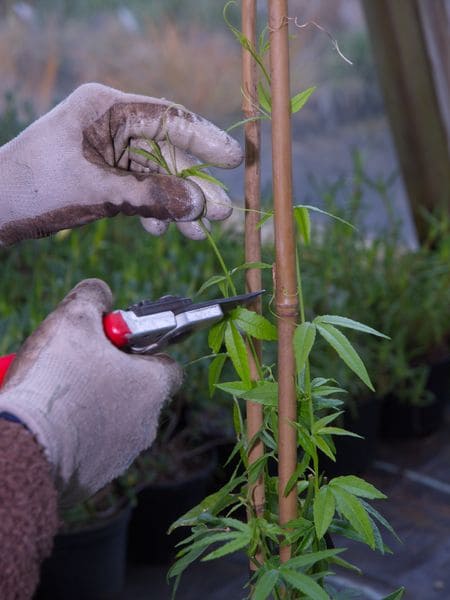
During the growing season, trim runner shoots monthly to redirect energy back to the main vine. If you want to prevent fruit and seed production (which reduces wildlife value but limits spread), remove spent flowers before fruit development.
Propagation: Growing Your Collection
Seed Starting Success
Collecting and planting seeds offers an economical way to expand your passion flower collection or share with friends. Harvest fully ripe, wrinkled maypops in fall, process by removing seeds from pulp and cleaning thoroughly, then soak seeds in warm water for 24 hours before planting.
Sow in seed-starting mix kept at 80-85°F—a heat mat significantly improves germination rates. Expect sprouting anywhere from 2-8 weeks, though some seeds may take months. The waiting tests patience, but the reward of growing your own plants from seed provides deep satisfaction.
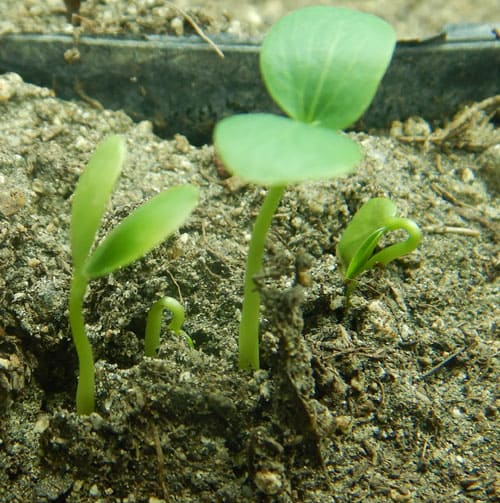
Seeds remain viable for several years when stored properly. Clean, dry seeds kept in cool, dry conditions maintain good germination rates for 3-4 years.
Cutting Propagation for Quick Results
Taking cuttings gives much faster results than seed starting. In early summer, select 6-8 inch pieces from new growth, remove lower leaves, and dip in rooting hormone before placing in a perlite-based rooting mix.
👉 Here’s How to Make Willow Water: The Best Natural Rooting Hormone
Keep the cuttings humid and warm (75-80°F) for 4-6 weeks. A simple plastic bag tent or humidity dome works well. Most cuttings root readily, and you can transplant them to individual pots once well-established.
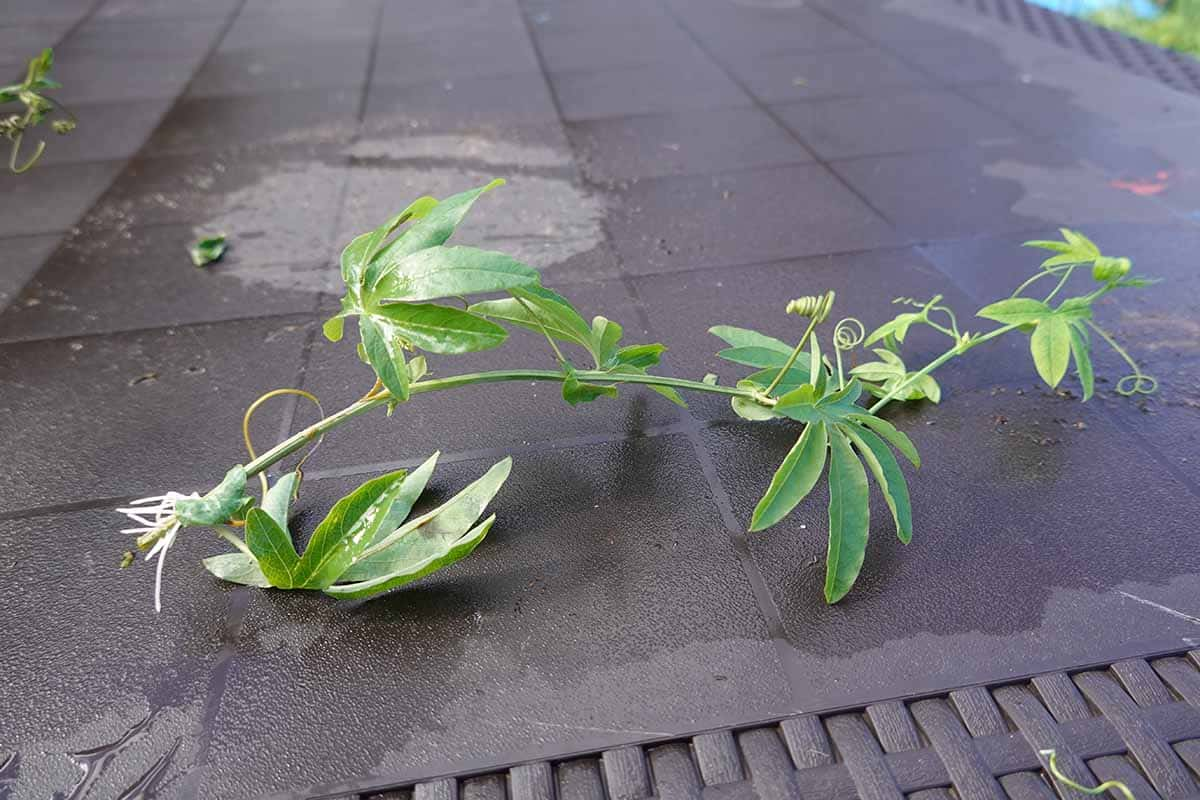
Division: The Easiest Method
The simplest propagation method involves dividing existing plants. In early spring before active growth begins, locate a runner shoot with its own root system. Carefully excavate to ensure good root attachment, then transplant immediately to its new location.
Water regularly until established—usually 4-6 weeks. This method has nearly 100% success rate and gives you full-sized plants much more quickly than other propagation methods.
Creating a Wildlife Paradise
One of my greatest joys in growing purple passion flower has been watching it transform into a butterfly nursery each summer. This vine serves as the exclusive host plant for several stunning butterfly species, creating a living laboratory right in your garden.
The Butterfly Life Cycle
Gulf fritillary butterflies with their bright orange wings and silver spots lay eggs on the vine in late spring. The resulting spiky orange caterpillars consume leaves voraciously through summer, often completely defoliating the plant by late August. Don’t panic when this happens—it’s exactly what should occur!
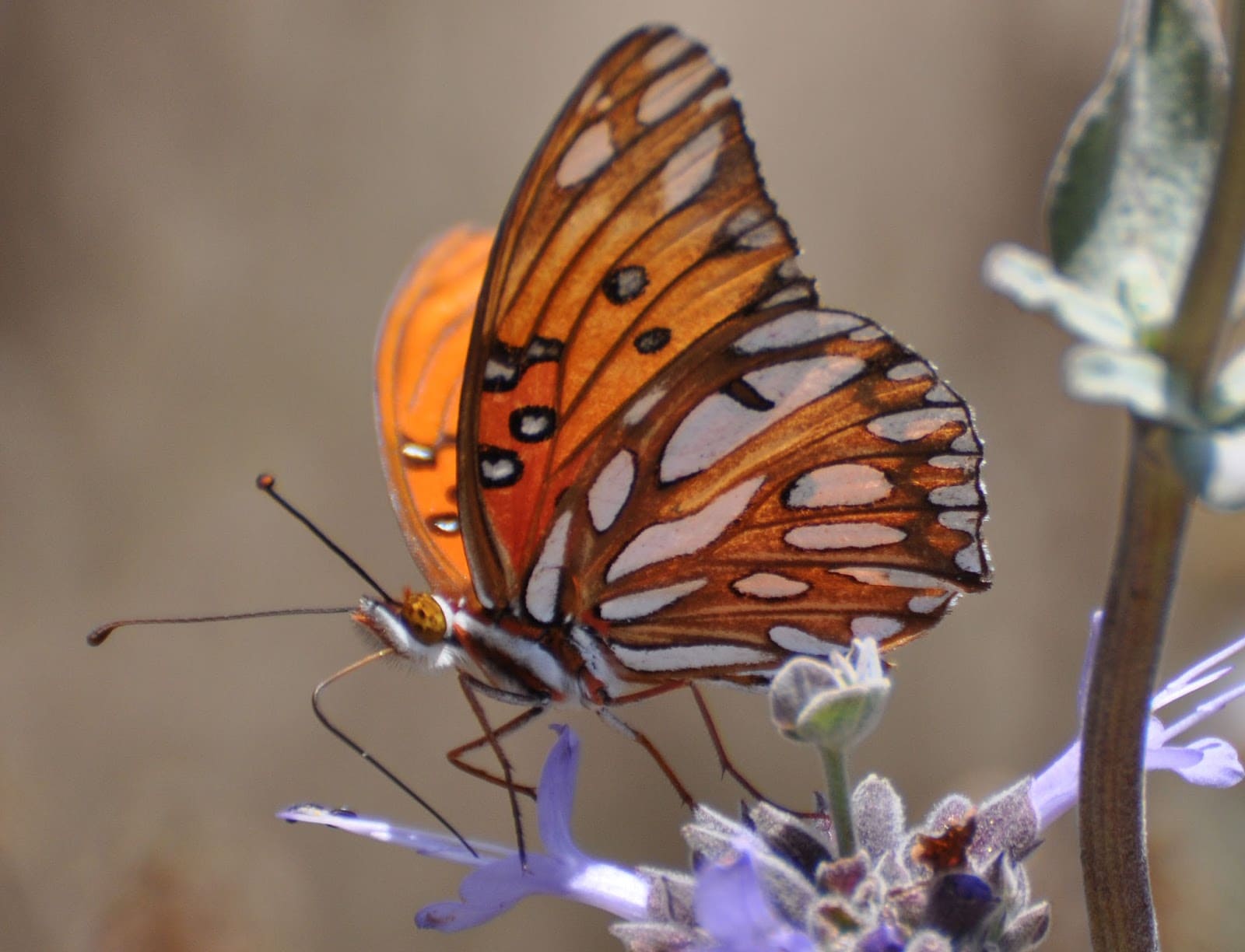
Zebra longwings, with their distinctive black and yellow striped wings, follow a similar pattern but in smaller numbers. Variegated fritillaries add orange wings with intricate black markings to the mix. Each species has slightly different timing, providing continuous butterfly activity throughout the growing season.
Beyond Butterflies
The sophisticated flowers attract an amazing diversity of pollinators. Carpenter bees, which are perfectly sized for the flower’s architecture, serve as primary pollinators. Their methodical visits from flower to flower ensure excellent fruit set.
Bumblebees often become visibly intoxicated from the nectar, a phenomenon that delighted Victorian naturalists and continues to amuse modern gardeners. Ruby-throated hummingbirds occasionally visit, drawn by the flower’s exotic appearance and copious nectar production.
👉 Here’s How to Create a Hummingbird-Friendly Garden in Small Spaces: Easy Steps for Beginners
Native bees of various species appreciate the abundant nectar source, while songbirds relish the ripe fruits in fall. Even deer tend to avoid the plant, making it valuable in areas with browsing pressure.
Harvesting and Enjoying Your Maypops
Recognizing Perfect Ripeness
Timing the harvest correctly makes all the difference in fruit quality. Maypops are ready when they feel slightly soft to the touch, develop a yellowish color (though some remain greenish), begin to wrinkle slightly, and most importantly, fall naturally from the vine.
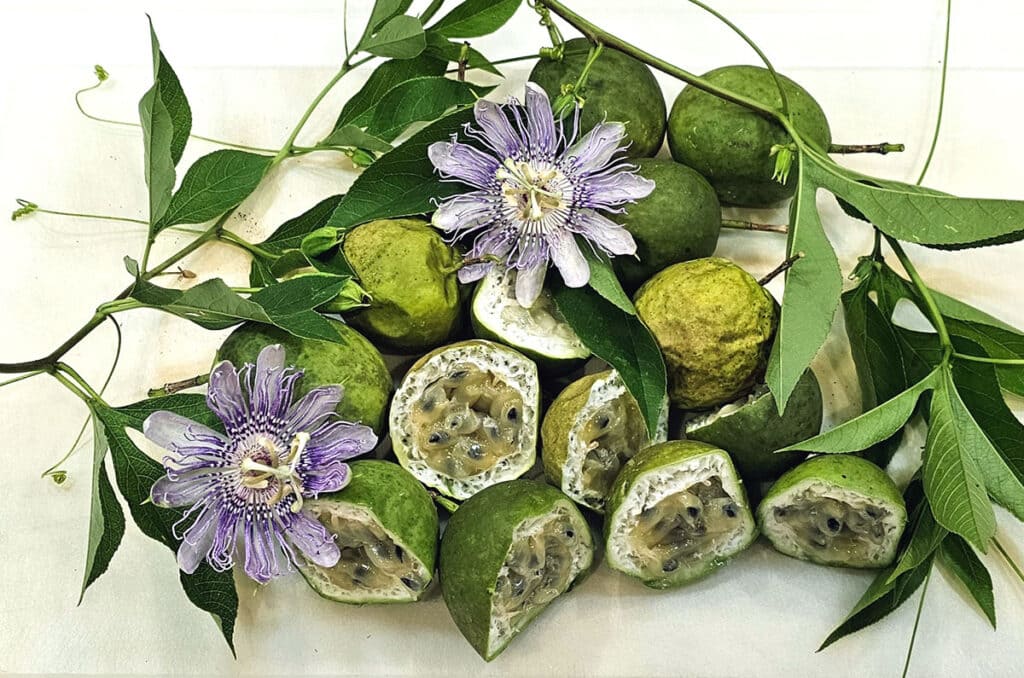
I’ve learned to place old sheets or tarps under heavily fruited vines in early fall—this catches the naturally dropping fruit and saves me from daily hunting expeditions. Fruit that drops overnight is usually at perfect ripeness.
Processing and Storage
Fresh maypops are best enjoyed immediately after harvest. Cut or crack open the leathery skin to reveal the aromatic interior filled with seeds surrounded by delicious pulp. The entire contents are edible, though some people prefer to strain out the seeds for juice making.
The flavor profile is complex—tropical and perfumed with notes of guava, apricot, and passion fruit. It’s unlike anything else you’ll grow in a temperate garden. Fresh fruit keeps for several days at room temperature or up to a week refrigerated.
Culinary Adventures
I’ve experimented with maypops in various culinary applications over the years. The natural pectin content makes exceptional jellies and jams that set beautifully without added pectin. The fresh juice mixed with sparkling water creates a refreshing summer drink with exotic flair.
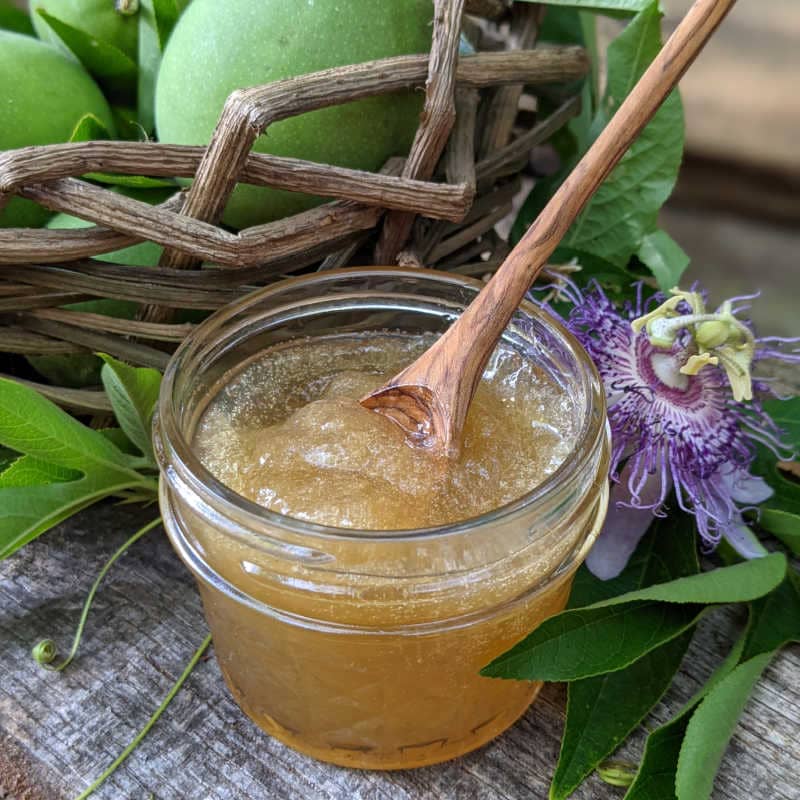
For dessert applications, the pulp works beautifully in ice creams and sorbets, providing natural tropical flavor and appealing texture. I’ve even used it in cocktail applications, where the unique flavor profile creates memorable drinks for adventurous guests.
Troubleshooting Common Challenges
When Flowers Don’t Come
Poor flowering frustrates many gardeners, but the causes are usually correctable. Lush green growth without flowers typically indicates too much nitrogen fertilizer—reduce feeding and switch to a lower-nitrogen blend. Young vines may take 2-3 years to flower well, so patience is essential with new plantings.
Insufficient sunlight also reduces flowering significantly. If your vine receives less than 6 hours of direct sun, consider transplanting to a brighter location or pruning nearby shade-creating plants.
Managing Pest Issues
Japanese beetles can devastate young foliage when they discover your vine. Hand-picking in early morning when they’re sluggish provides immediate relief. Pheromone traps work but place them well away from your vine to avoid attracting more beetles to the area.
Scale insects occasionally establish on stems, appearing as small brown bumps. Horticultural oil applied during dormant season effectively controls these pests. For active infestations, systemic insecticides may be necessary.
Spider mites thrive in hot, dry conditions, causing stippled, yellowing leaves. Increase humidity around the plant and consider releasing predatory mites for biological control in severe cases.
Disease Prevention and Treatment
Root rot from poor drainage kills more passion flowers than all other problems combined. If your vine shows yellowing leaves and poor growth despite adequate care, check soil drainage and consider relocating to a better-draining site.
Leaf spot diseases occasionally appear in humid conditions with poor air circulation. Ensure adequate spacing between plants and avoid overhead watering. Remove affected foliage promptly to prevent spread.
Viral issues, while rare, can cause stunted growth and mottled leaves. Unfortunately, there’s no cure—remove affected plants promptly to prevent spread to healthy vines.
Zone-Specific Winter Protection
Winter protection requirements vary significantly by hardiness zone. Zone 5-6 gardeners should cut stems to 6 inches and apply 4-6 inches of mulch before the first hard freeze. Consider additional protection like burlap wraps in extremely cold areas.
Zone 7 gardeners can often leave 12-18 inches of stem, though protection with mulch remains wise. Some stems may survive in protected locations, giving you a head start on spring growth.
Zones 8-9 typically require only light pruning and minimal winter protection, though unusually cold snaps can damage exposed growth even in these mild zones.
Frequently Asked Questions
- How fast does purple passion flower actually grow?
In optimal conditions, established vines can grow 12-20 feet in a single season, though young plants may be slower the first year while establishing their root system. The underground runner system can spread even faster than the above-ground growth.
- Will it really take over my entire yard?
Without management, yes—this plant can be quite aggressive in spreading. However, with regular pruning and runner removal, it’s entirely manageable. Many gardeners successfully grow it for decades without major invasion problems.
- Do I need multiple plants for fruit production?
While purple passion flower can self-pollinate, cross-pollination from a second plant typically results in better fruit set and larger harvests. If space allows, two plants provide insurance against poor pollination seasons.
- Is the plant safe around children and pets?
The ripe fruit is perfectly safe and delicious to eat. However, teach children not to eat plant parts without permission, as young leaves and unripe fruit should be avoided. The plant has no serious toxicity issues for pets in normal circumstances.
- How long do established plants typically live?
With proper care, purple passion flower vines can live 10-15 years or more, continuously expanding through their root system. The underground portion often outlives individual stems by many years.
- Can I grow it successfully in containers long-term?
Absolutely! Container growing actually helps control the aggressive spreading while maintaining all the ornamental and wildlife benefits. Plan on repotting every 2-3 years and providing winter protection for the containers in cold climates.
Embracing Wild Beauty in Your Garden
Growing purple passion flower has taught me that sometimes the most rewarding garden plants are those that challenge our desire for complete control.
Yes, this vine requires management and respect for its vigorous nature. But in return, it offers an unparalleled display of exotic beauty, supports crucial wildlife, and provides delicious fruit—all while being tough enough to thrive in climates where most passion flowers would perish.
The daily miracle of watching those intricate flowers unfold never gets old. Each bloom represents a perfect example of nature’s artistry, while the visiting butterflies and bees remind us that our gardens can serve purposes far beyond mere decoration. When autumn brings the sweet reward of fresh maypops, the cycle feels complete.
If you’re ready to invite a little wildness into your garden, purple passion flower might be the perfect choice. Start with proper site selection, provide adequate support, and prepare to be amazed by both the challenges and rewards this remarkable plant offers.
Remember to give it the space and structure it needs, stay vigilant about controlling its spread, and most importantly, take time to appreciate the daily wonder of those incredible flowers.
Whether you’re drawn by the botanical curiosity, the butterfly habitat potential, or simply the desire to grow something truly spectacular, purple passion flower rarely disappoints.
The journey from that first roadside discovery to a garden full of purple passion flowers has been one of the most rewarding aspects of my gardening adventures. I hope this guide helps you create your own success story with this extraordinary native plant.
